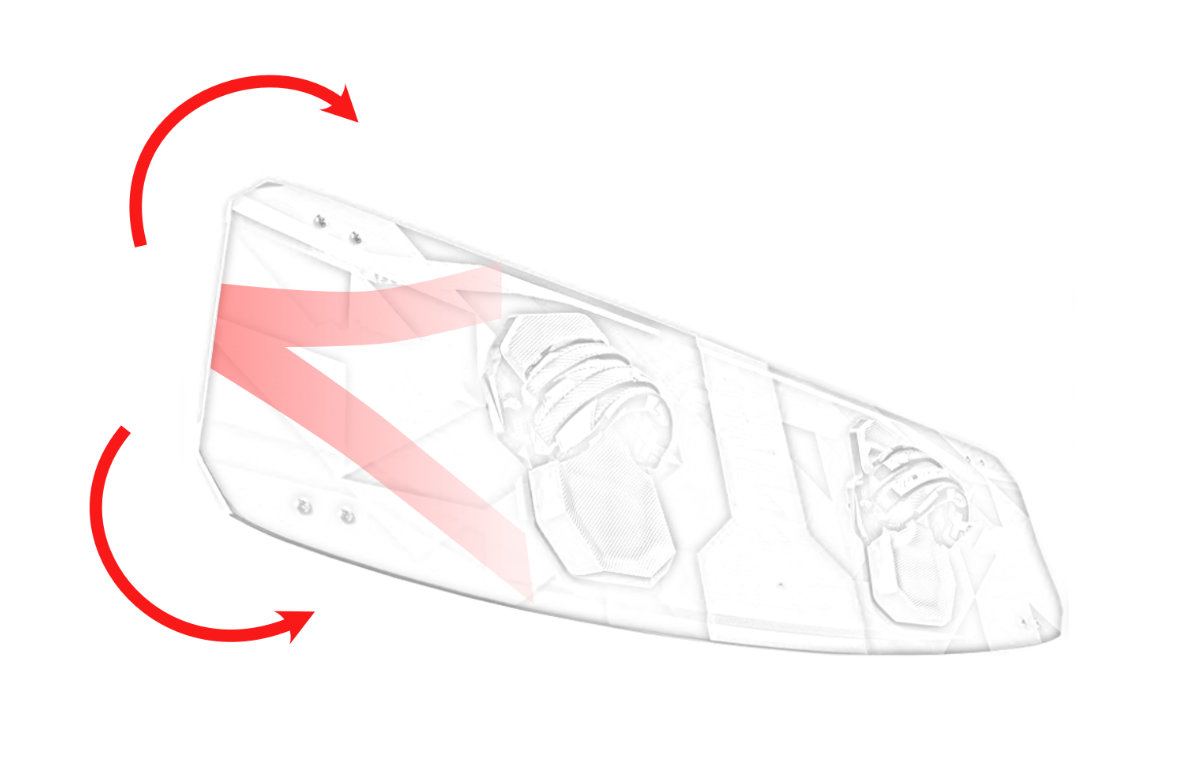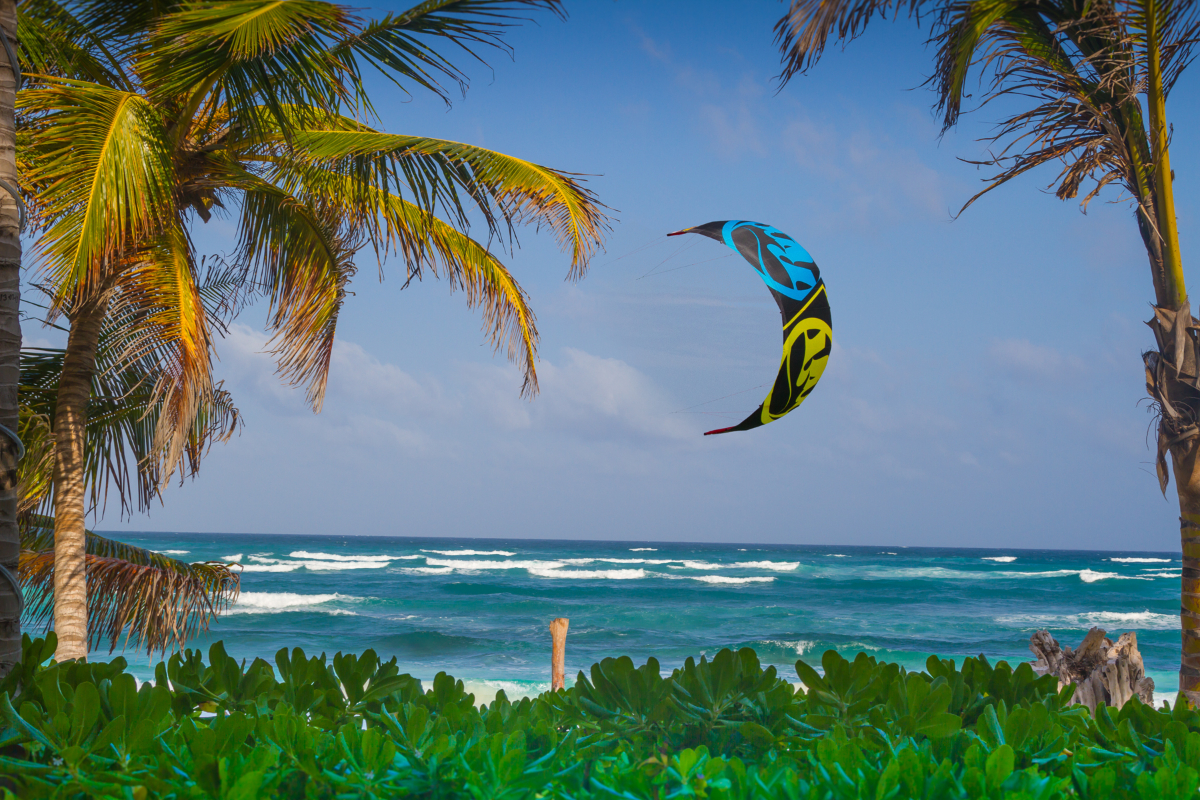Hidden benefits of pads settings in our twin tip kiteboards
Very often we overlook the pads regulations on our twin tip boards, losing a lot of advantages they can offer.
Intuitively those settings on our kiteboard twin tip seem to be necessary to adjust the dimension of the stance to a comfortable position for our body size.
Partially it can be true, those five cms of different spacing in the stance can be a good accommodation, but in reality, this will have a limited effect on your body position. The effect will be way more important on the board behavior in regard to its stiffness.

The main reason for a change in the position of your bindings is the modification of the kiteboard flex.
Of course, different boards offer different flexibility: fiberglass kiteboards are more flexible than carbon-reinforced ones, the same for thicker or thinner profiles.
That influences the purchase choice concerning the behavior we desire and our weight. But in this post, we are focusing on the effect of the stance set up on the same board, once we have it.
As said, the stance changes the flex behavior of the board, this is very important for two aspects:
1. the desired riding style and the conditions;
2. the weight of the rider.
A lot of people purchase the board with the standard-setting and they use it without ever give a try to different ones, maybe complaining of some ‘bad’ characteristics of the board, which they could easily amend with a correct setup.
The flex of the board is dramatically influenced by the position of the foot straps. By differently loading the tips and shortening the bending length of them the response of the board changes. In fact, every kiteboard has an internal flexing pattern that depends on the different thicknesses in various parts of it and on how the different reinforcing fibers (wood, carbon, fiberglass) are placed or how many layers of them were added to the board's core.
Whether it is a continuous rocker twin tip or a 3-stage rocker board, the flex tends to be high on the tips and decrease going towards the center of the board. Therefore, the stiffness is concentrated in the center and reduced on the tips:

In most refined twin-tips the producer inserts also more elaborated flexing patterns such as v-flex zones in the tips, to improve the torsion and therefore the easy turn and carving capabilities. This is especially true for freeride kiteboards, while for wake style boards work on the contrary with very stiff torsion tips.

All these flex properties of the twin-tip boards are dramatically influenced by the stance of the pads: the more the footpads are moved towards the tips, the less flex, and torsion the board can offer.

The result will be in a more or less rigid kiteboard. A stiffer board will provide a way better stability and response during the most aggressive maneuvers. The downside will be a higher load on knees and ankles and a stronger effort to hold the board during the ride, with increased vibrations. A softer twin-tip on the opposite will be way gentler on the legs and it will turn more easily, which will be paid with a limited sharpness in hard action like strong edging for the pop in radical tricks.
So, for wake style kiteboard a larger stance will be more suitable adding rigidity to the board and way more stability to the rider.
In freeride conditions, especially on choppy waters, the ideal stance is less wide, to benefit from higher flexibility of the tips to absorb the rough bumps from the water surface, for a smoother gait and better maneuverability when turning.
Obviously, you can see on the different types of boards the choice of the producer to widen or to narrow the positions of the connectors to the pads and to change the flex response with thicker or thinner board layers.

Another aspect that influences how the pad setups should be used is the rider's weight. In fact, a very heavy rider most likely tends to make the rocker of the board increase due to his body mass. That can destabilize the balance of the board, specifically reducing the grip on the water. In this case, the larger setup on the footpads will allow once more to have more rigid tips. The extra rigidity will allow recovering of the necessary stiffness to avoid too accentuated deformations of the board and therefore too pronounced rocker, recovering the necessary stability in gait.
In the end, if you find yourself dealing with a very stiff and uncomfortable board, before labeling it as too hard, try to change the foot straps position narrowing the stance. You may find yourself amazed by how the feeling of the board changes as the flexibility of the tips increases.
The suggestion is to try the different pad settings on the board, don't be afraid to experiment, this will allow you to find the best balance for your sessions.
The other adjustment available for the latest generation pads is instead the inclination of the foot inside the pads in relation to the longitudinal axis of the board: this adjustment is a matter of comfort and is usually more subjective,
A recommendation is to pay attention to the comfort you have while riding and, if you feel too much pressure on the outside of your foot, you probably need to tilt the pad more towards the external side, while if the pressure is on the inside of the foot, it should help the opposite operation.

If you feel pain in the inside of the knee, most likely it is advisable to rotate the pads in order to have them more parallel to each other (image on the right). In fact, there is an increased risk of inner inside knee injury with too open a stance.
This, by reducing the torsion on the pads, will also extend their life.
Especially for new generation foot straps, where the connections are plastic plates, a continuous twisting could progressively weaken them.

Even in the case when we are adjusting the position of the binding longitudinally as discussed before, an adjustment of the inclination setting should be necessary, with greater inclinations for more open stances and vice versa.
The last adjustment we can have on the pads is their position in the transversal direction. We can have the footpad more in the center of the board or closer to the heel side.

The more the board is in the center, the more stability we have when landing jumps. The downside is a slightly harder effort when edging heelside. On the opposite, having the pads closer to the heelside will help in edging, but might lead to lesser stability when landing jumps. A good piece of advice is to use this second setup if you suffer from pain through your shins, otherwise keeping the pads more centered can have more advantages.
What do you think about the above topic? Do you agree with the description of the various effect of the stance on the twin-tip board?
Comment below and let us know what you think.

Travel Mug

Logo: Peace Balance Wind
Promote your Kite School for free!
Index your Kite School in our database.
You will get free lifetime visibility on Kitesurf Culture website.
If you have a website, it will provide precious backlinks to improve your SEO ranking
Relevant Posts

Kitesurfing wave boards, do you want to give them a try?

The Kitesurf session ended: tips for Kite Gear Maintenance

How to Give Your Kitesurfing Equipment a Double Lifespan

How to Choose the Best Kitesurfing Equipment (Part Two)

How to Choose the Best Kitesurfing Equipment (Part One)
Get free Kitesurfing Resources and Tips
If you like our content and you want to be informed on the next blogposts release, please subscribe here. That will also help us to continue to provide quality content:
Give us your opinion.
Mouse pad

Logo: Riding the wind surfing the waves
Promote your Kite School for free!
Index your Kite School in our database.
You will get free lifetime visibility on Kitesurf Culture website.
If you have a website, it will provide precious backlinks to improve your SEO ranking
Relevant Posts

Kitesurfing wave boards, do you want to give them a try?

The Kitesurf session ended: tips for Kite Gear Maintenance

How to Give Your Kitesurfing Equipment a Double Lifespan

How to Choose the Best Kitesurfing Equipment (Part Two)

How to Choose the Best Kitesurfing Equipment (Part One)
Computer Backpack

Logo: Kitesurfing: making gravity optional since 1977
Latest Posts

Kitesurfing Dubai: an honest guide. Tips, Spots & Winds

Unwind and learn: best beginner kitesurfing spots worldwide

Self-Rescue in Kitesurfing: A Crucial Guide to Safety

Kitesurf Ometepe: an Epic Kite Trip to Nicaragua

Kitesurfing Spring in Andalucia: Unexpectedly Great!